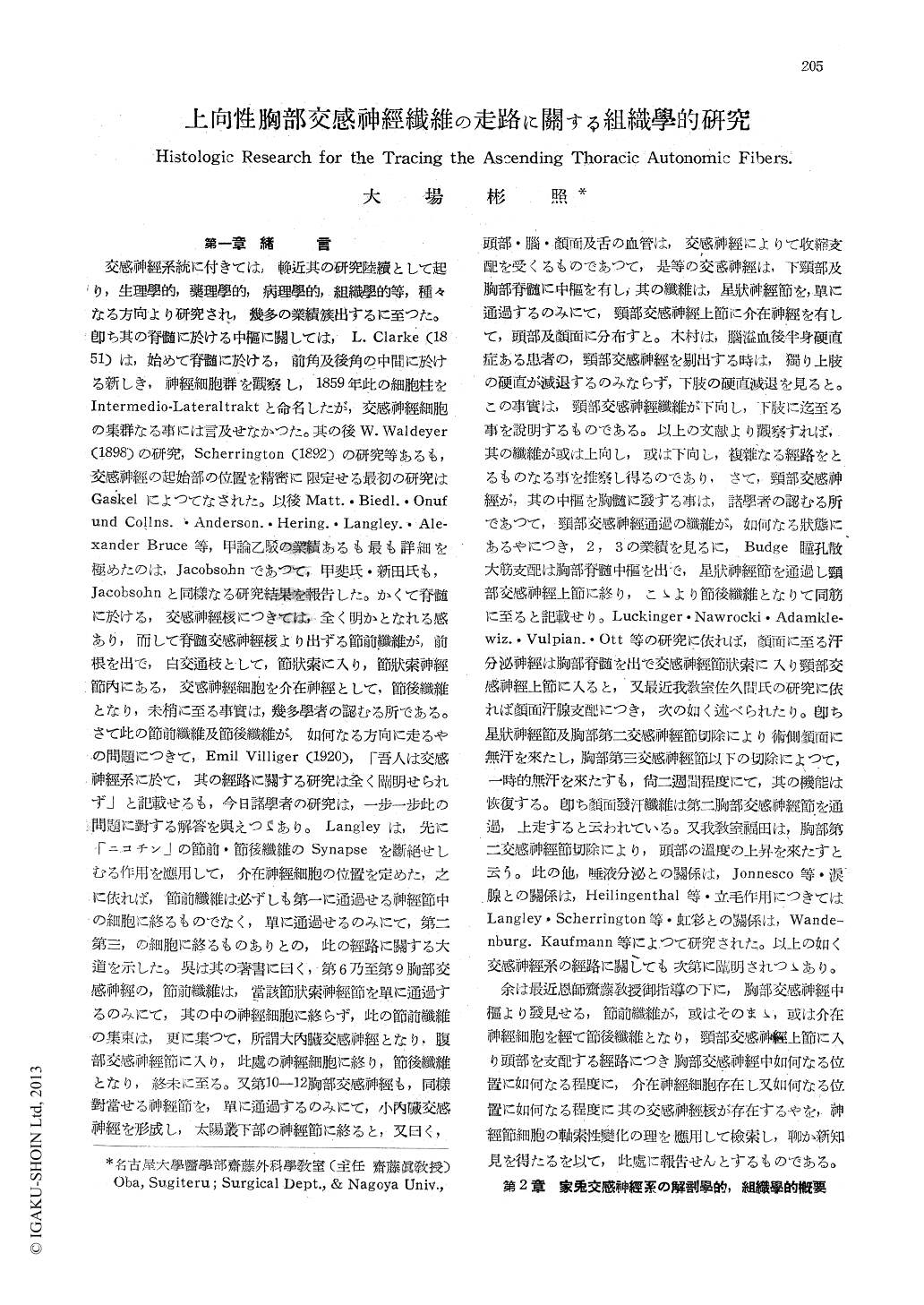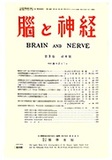Japanese
English
- 有料閲覧
- Abstract 文献概要
- 1ページ目 Look Inside
第一章 緒言
交感神經系統に付きては,輓近其の研究陸續として起り,生理學的,藥理學的,病理學的,組織學的等,種々なる方向より研究され,幾多の業績簇出するに至つた。即ち其の脊髄に於ける中樞に關しては,L. Clarke (1851)は,始めて脊髄に於ける,前角及後角の中間に於ける新しき,神經細胞群を觀察し,1859年此の細胞柱をIntermedio-Lateraltraktと命名したが,交感神經細胞の集群なる事には言及せなかつた。其の後W.Waldeyer(1898)の研究,Scherrington (1892)の研究等あるも,交感神經の起始部の位置を精密に限定せる最初の研究はGaskelによつてなされた。以後Matt.・Biedl.・Onuf und Collns.・Anderson.・Hering.・Langley.・Ale-xander Bruce等,甲論乙駁の業績あるも最も詳細を極めたのは,Jacobsohnであつて,甲斐氏・薪田氏も,Jacobsohnと同樣なる研究結果を報告した。かくて脊髄に於ける,交感神經核につきでは,全く明かとなれる感あり,而して脊髄交感神經核より出ずる節前纖維が,前根を出で,白交通枝として,節状索に入り,節状索神經節内にある,交惑神經細胞を介在神經として,節後纖維となり,未梢に至る事實は,幾多學者の認むる所である。さて此の節前纖維及節後纖維が,如何なる方向に走るやの問題につきて,Emil Villiger (1920),「吾人は交感神經系に於て,其の經路に關する研究は全く闡明せられず」と記載せるも,今日諸學者の研究は,一歩一歩此の問題に封する解答を與えつゝあり。Langleyは,先に「ニコチン」の節前・節後纖維のSynapseを斷絶せしむる作用を應用して,介在神經細胞の位置を定めた,之に依れば,節前纖維は必ずしも第一に通過せる神經節中の細胞に終るものでなく,單に通過せるのみにて,第二第三,の細胞に終るものありとの,此の經路に關する大道を示した。呉は其の者書に曰く,第6乃至第9胸部交感神經の,節前纖維は,當該節状索神經節を單に通過するのみにて,其の中の神經細胞に終らず,此の節前纖維の集束は,更に集つて,所謂大内臓交感神經となり,腹部交感神經節に入り,此處の神經細胞に終り,節後纖維となり,終未に至る。又第10-12胸部交感神經も,同樣對當せる神經節を,單に通過するのみにて,小内臓交感神經を形成し,太陽叢下部の神經節に終ると,又曰く,頭部・腦・顔面及舌の血管は,交感神經によりて收縮支配を受くるものであつて,是等の交感神經は,下頸部及胸部脊髄に中樞を有し其の纖維は,星状神經節を,單に通過するのみにて,頸部交感紳經上節に介在神經を有して,頭部及顏面に分布すと。木村は,腦溢血後半身硬直症ある患者の,頸部交感神經を剔出する時は,獨り上肢の硬直が減退するのみならず,下肢の硬直減退を見ると。この事實は,頸部交感神經纖維が下向し,下肢に迄至る事を説明するものである。以上の文献より觀察すれば,其の纖維が或は上向し,或は下向し,複雜なる經路をとるものなる事を推察し得るのであり,さて,頸部交感神經が,其の中樞を胸髄に發する事は,諸學者の認むる所であつて,頸部交感神經通過の纖維が,如何なる状態にあるやにつき,2,3の業績を見るに,Budge瞳孔散大筋支配は胸部脊髄中樞を出で,星状神經節を通過し頸部交感神徑上節に終り,こゝより節後纖維となりて同筋に至ると記載せり。Luckinger・Nawrocki・Adamkle—wiz.・Vulpian.・Ott等の研究に依れば,顏面に至る汗分泌神經は胸部脊髄を出で交感神經節状索に入り頸部交感神經上節に入ると,又最近我教室佐久間氏の研究に依れば顏面汗腺支配につき,次の如く述べられたり。即ち星状神經節及胸部第二交感神經節切除により術側顏面に無汗を來たし,胸部第三交感神經節以下の切除によつて,一時的無汗を來たすも,尚二週間程度にて,其の機能は恢復する。即ち顏面發汗纖維は第二胸部交感神經節を通過,上走すると云われている。又我教室福田は,胸部第二交感神經節切除により,頭部の温度の上昇を來たすと云う。此の他,唾液分泌との關係は,Jonnesco等・涙腺との關係は,Heilingenthal等・立毛作用につきてはLangley.・Scherrington等・虹彩との關係は, Wande—nburg. Kaufmann等によつて研究された。以上の如く交感神經系の經路に關しても次第に闡明されつゝあり。
余は最近恩師齋藤教授御指導の下に,胸部交感神經中樞より發見せる,節前纖維が,或はそのまゝ,或は介在神經細胞を經て節後纖維となり,頸部交感神經上節に入り頭部を支配する經路につき胸部交感神經中如何なる位置に如何なる程度に,介在神經細胞存在し又如何なる位置に如何なる程度に其の交感神經核が存在するやな,神經節細胞の軸索性變化の理を應用して檢索し,聊か新知見を得たるを以て,此處に報告せんとするものである。
Regarding the tract that rises and ascends from the thoracic sympathetic centre as preg-anglionic fibers or as postganglionic fiber after synaptically relating to ganglia and communic-ates superior cervical gangion and controlls the cepharic portion, we studied questions as follow-ing.
Where are the spinal ganglia corresponding to autonomic ganglia?
How much these ganglia extend in spinal cord?
Where are these autonomic ganglia?
How many these ganglia situate in sympathe-tic ganglia?
For this purpose we applied the theory of retrograde degeneration of nervous system and used rabbits, and thus we got the results as following,
OPERATIONS METHOD AND RESULTS 1. Extraction of superior cervical ganglion.
2. a) Amputation of sympathetic trunk bet-ween 7th and 8th thoracic sympathetic ganglion.
b) Amputation of sympathetic trunk bet-ween 6th and 7th thoracic sympathetic ganglion.
c) Amputation of sympathetic trunk bet-ween 5th and 6th thoracic ganglion.
d) Extraction of ganglion stellatae.
Rabbits were sacrificed 2 weeks after the operation.
(In this period the retrograde degeneration reaches to its top). The behaviour of the thora. cic spinal ganglia and autonimic ganglia are in-vestigated by Toluidin-blue strain.
1. The postoganglionic fibers rising from thra-cic ganglia that pass through superior cervical ganglion and end its termination, rise mostly from 1st and 2nd thoracic ganglion.
2. Although the most part of the postganglionic fibers rising from 3rd thoracic ganglion ascend, but less of them pass through superior cervical ganglion.
3. A few of the postoganglionic fibers rising from 4th & 5th thoracic ganglion pass through superior cervical ganglion and end to its ter-mination.
4. There are very few postoganglionic fibers rising from ganglia under the 5th thoracic gan-lion.
5. The preganglionic fibers rising from thoracic spinal cord that correspond to superior cervical ganglion rise from 1st & 2nd thoracic spinal cord.
6. Although the most part of the preganglionic fibers arise from 3rd thoracic spinal ganglion ascend, but less of them communicate superior cervical ganglion.
7. A few of the preganglionic fibers, rising from 4th & 5th thoracic spinal ganglion communi-cate superior cervical ganglion.
8. There are very few ascending preganglinic fibers that communicate to superior cervical ganglion, and rise from spinal ganglia under 5th thracic spinal ganglia.

Copyright © 1951, Igaku-Shoin Ltd. All rights reserved.


